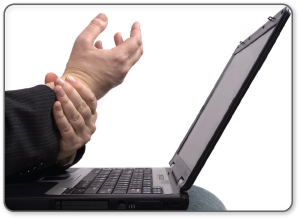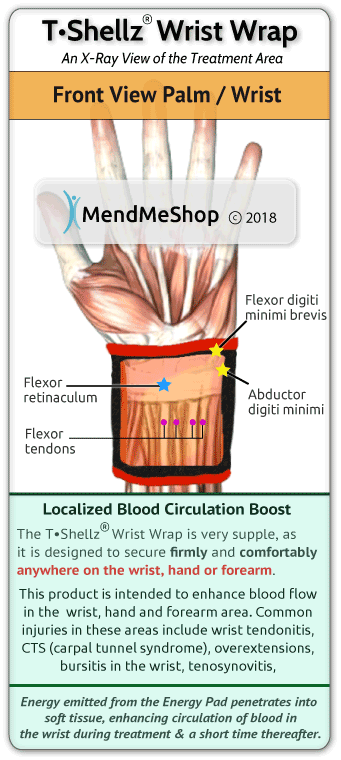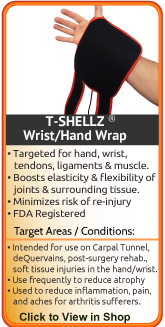de Quervain's Tendonitis/Tendinitis
Thumb Tendinitis, de Quervains Tenosynovitis, Quervain's Stenosing Tenovaginitis (sometimes referred to as "new mom's syndrome")
De Quervain's Syndrome is an inflammatory condition that is commonly caused by cumulative injury, and is one of the most common diagnosed conditions treated by hand surgeons. Carpal Tunnel Syndrome also theorized to be caused by repeated and cumulative trauma, is one of the major causes of lost workdays at the present time. Regarding de Quervain's tenosynovitis, there is potential for symptoms to show elsewhere in the arm other than the area involving the tendon. This can result from the close proximity of the nerves, tendons, sheaths, and fascia of the forearm to the site of inflammation.
Symptoms and Diagnosis
de Quervain's tendonitis was initially common in new mothers who hyper-extended their thumbs while holding the head of their babies. This syndrome is also fairly common in older individuals as well.
The primary symptom of de Quervains tendonitis is pain at the base of the thumb near the wrist. The pain can be sudden and sharp or increase on a gradual basis with use of the thumb or hand. de Quervains is almost always associated with tenderness and swelling of the styloid process of radius bone. Pain can radiate into the forearm and thumb.
de Quervains tenosynovitis is the thickening and inflammation of the sheath containing the tendons of the inner wrist and thumb area (extensor pollicis brevis and abductor pollicis longus tendons). de Quervain's Tendonitis results from inflammation or constriction of the tendons of the muscles of the thumb at the point where they pass into the wrist. In many cases both tenosynovitis and tendonitis occur, a condition known as tendinopathy.
Diagnosis of this condition is based on the location of pain, decreased hand function, and the presence of swelling in the hand.
Surgery
Surgery is not usually necessary, and is typically the option of last resort. A troublesome complication of surgery for de Quervains tenosynovitis is a painful neuroma of the radial nerve as well as increased presence of scar tissue due to the invasive nature of surgery. Controlled exercise several times daily is commonly recommended, especially to prevent frozen shoulder, after the acute inflammation is controlled. Injection within the tendon sheath of a corticosteroid is also sometimes very helpful.
A physician/surgeon will typically start to consider surgery for de Quervains Syndrome if the condition persists after conservative treatment options have been tried for at least 3 months. In most cases, the surgery for de quervain's tenosynovitis is "day surgery", meaning you will most likely not be kept overnight in the hospital after surgery.
Surgery is typically performed using a local anaesthetic with sedation. A small incision is made and the compartment confining the tendon is divided. Once surgery is complete, you will most likely be required to wear a splint for a couple weeks and then undergo stretching/strengthening with the physical therapist later.
De Quervains Syndrome Conservative Treatment Options
The trick to any tendon injury is getting it to heal with minimal scar tissue formation and with as much realignment of tendon fibers as possible. To achieve this, your doctor will most likely recommend up to 6 months of conservative treatments. Even with optimum healing there is always less elasticity in a previously injured tendon. The trick is to make sure you heal it the best you can, that way your chance of re-injury down the road is much lower than average - which is well over 50%.
The wrist will continue to be inflamed until you allow it to rest from the pain causing activity. Continued damage will cause chronic inflammation, secondary adhesion and general degeneration of the tendon. The tendon sheath itself will probably be injured as the tendon swells, increasing the pain of the condition. When treating the wrist tendon(s), rest the area, apply cold compression for 10-20 minutes at a time for at least 3 times a day. Do this to the injured area for the first day to 3 days of inflammation or longer until the swelling calms down.
The Wrist TShellz Wrap® may be used after the acute swelling has improved; the TShellz Wrap® will stimulate blood flow in the local area, while also warming up the tissue. It is known that warmed tissue will experience a larger range of motion and increased extensibility and this is exactly what you want when you are trying to recover from a soft tissue injury. Increased extensibility and flexibilty in soft tissue means it is less likely to strain or tear further during activity, and less re-injury during this period means less setbacks during healing. Less re-injury helps minimize the build up of scar tissue around the tendon during the healing process, while also reducing the risk and severity of overcompensation pain and secondary injuries. Basically, the value of a faster recovery is often underestimated, as the impact of chronic injuries can quickly spiral out of control.
Why Wrist Tendonitis Can Persist
Often when a tendon injury occurs, the injured area is rested a bit, a pain killer is taken and we continue on with our normal activities. If the strain was minor, the body may be able to heal the tendon fibers normally. Unfortunately, this is not the usual result because the injured tendon is being used instead of rested. Because of the stress on the tendon, the body heals the injured fibers by binding them together with fibrotic adhesions or scar tissue. This is done in an attempt to prevent further damage to the injured area. It is a normal protective response of the body, but buildup of scar tissue can and does become a big problem over the long term.
Scar tissue buildup is one of the main reasons we advocate the use of a TShellz Wrap® over the long term once the swelling is down. Much of the pain may have disappeared with the swelling, but that does not mean your tendonitis has healed. The trick is to continue boosting blood flow to the area on a daily basis, helping keep tissues in the area flexible and less likely to strain while your tendon(s) continue to build up strength.
A General Breakdown of Home Conservative Treatment Options
- Rest - This is important for initial healing to reduce pain, swelling and inflammation in the early stage of your tendon injury. Too much rest can also be harmful as joint immobility can actually cause stiffening, overcompensation and atrophy (shortening & wasting away of soft tissue). This is why rest should be used when reducing initial pain and swelling, but should not be considered for more long-term conservative treatment.
- Avoid Activities that Caused Your Injury - While resting your problematic joint, it's important to avoid activities that may have caused your injury in the first place and this definitely includes pretty much any type of sport or repetitive movements that might be undertaken when working. Continuing on with regular activities will not only make your injury worse, but trying to 'work around' your injury will eventually give rise to over-compensation injuries in other areas of your body.
- Use a Cold Compress or Ice Pack - Cold is very effective at reducing pain and inflammation - use at the onset of the injury and during flareups.
- Use a TShellz Wrap® (Circulatory Boost device) Once The Swelling is Down - You can use your own blood flow to maximize your rehabilitation, maintain healthy blood flow to your soft tissue, decrease recovery time, and reduce re-injury risk. Promoting blood flow to the injury using a warming treatment will help to minimize the growth of scar tissue and increase flexibility. This is why we recommend TShellz Wrap before undergoing activity - an increase in flexibility should help reduce risk of further injury while also assisting in the battle against atrophy.
- Avoid Over Compensating for your Injury on your "'Healthy' (Non-Injured) Side - Many people will start limping or carrying objects with their opposite arm to compensate for their tendon injury. Our bodies can adapt easily to any changes, including a tendonitis injury. This quick adaptation could mean that you're already compensating for your injury without even knowing it!
When you compensate for your injury by using your opposite ('healthy') arm, leg, shoulder, knee, foot, etc. - then you are putting more weight and pressure on that side of your body. In many cases, your dominant side was injured (if you're right-handed this would be your right side) so your weaker side is trying to pick up the slack! The pain, stiffness, swelling and inflammation you then get on your 'healthy' side is something referred to as 'over-compensation pain'. Over-compensating for your injury can lead to other injuries and so that's why over compensation should be avoided at all costs OR treated with the same conservative treatment methods as your tendon injury.
- PT - Surgery is usually the last resort. This means doctors or surgeons typically won't perform a surgery until they feel that their patient has put effort into treating their injury with conservative treatment methods. This includes 4 to 6 months of visits to a PT. If you haven't experienced any improvement in your condition during that time then surgery may be considered. Agressive PT approaches will focus on forced or manual manipulation - this means your PTs will be trying to move you past the point of comfort as they strive to increase range of motion and prevent further atrophy.
- Stretching - Stretching your joint in PT and at home will help you to regain your range of motion much faster than not stretching at all. Stretching in many ways is key maintaining good Range of Motion (ROM) in your joint, and stretching can be made much easier with use of a TShellz Wrap® before to warm up soft tissue, and a Cold Compress or Ice Pack treatment after to prevent any return of swelling and inflammation.
Conservative Treatment Tools Our Clients Have Used to Help
Limit Damage & Boost The Body's Soft Tissue Repair Process at Home:
- A Cold Compress or Ice Pack to reduce inflammation of the soft tissue injury (as soon as possible).
- A TShellz Wrap to increase blood-flow to the treatment area.
- MendMeShop Arnica Pain Cream for temporary relief of pain due to sore muscles and joints.
- An Exercise & Stretching Plan to prevent muscle atrophy and shortened tendons. A proper plan will increase elasticity and strengthen the muscles and tendons in the area.
Conservative treatment tools just like these have been used successfully by thousands of tendon injury sufferers - just like you.

TShellz Wrap® = Enhanced Blood Flow in the Treatment Area We believe the use of TShellz Wraps® for boosting blood flow to soft tissue in the area of application is one of the most under-utilized home treatment options available on the market today. We have client after client that have tried many options out there and have been amazed at how effective and fast the TShellz Wrap treatment can relieve pain and increase blood flow in soft tissue.
With regular use of the TShellz Wrap:
- Your pain will be reduced.
- Due to increased blood flow, soft tissue in the treatment area will be expected to recover at an accelerated rate with reduced potential for re-injury.
- Tissue in the treated area should experience a larger range of motion and increased extensibility of collagen tissue due to the heat effect on soft tissue. This should translate into a reduced rate of re-injury occurrence as soft tissue is known to lengthen and become more flexible when exposed to warm temperature. (Chapter 9 of "Therapeutic Heat and Cold", 4th edition.
(amazon.com link - Ed. Justus F. Lehmann, M.D., Williams, and Wilkin)
Product Advisors are available 9:00 am to 5:00 pm Eastern Standard Time Monday to Friday.
Learn More About Tendon Injuries & TreatmentsI want to learn more about Post-Surgery Recovery I want to learn more about TShellz Wrap® Circulatory Boost I want to learn more about Ice & Heat: Which Is Better For Treatment? I want to learn more about Tendonitis Treatments I want to learn more about Tendonitis Surgery
FREE SHIPPING ON ALL PRODUCTS CURRENTLY ENABLED
60 DAY TRIAL PERIOD
During your recovery, you will probably have to modify and/or eliminate any activities that cause pain or discomfort at the location of your soft tissue injury until the pain and inflammation settle. The more diligent you are with your treatment and rehabilitation, the faster you will see successful results!
| 















